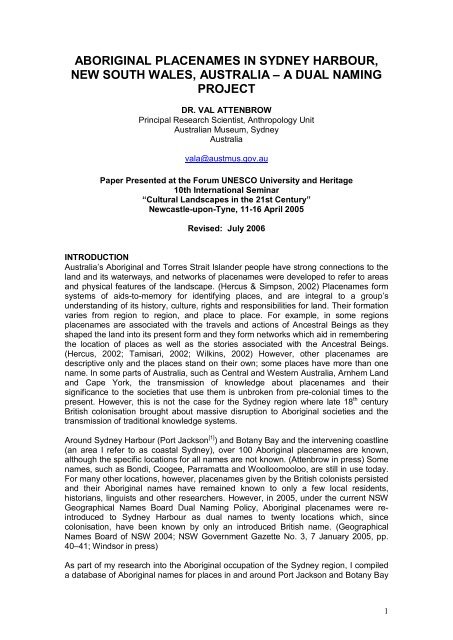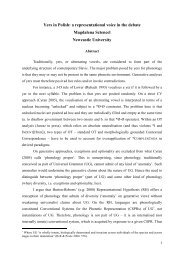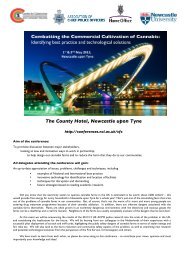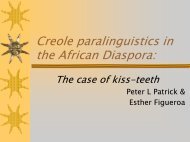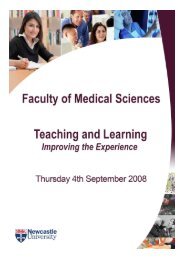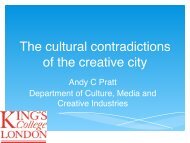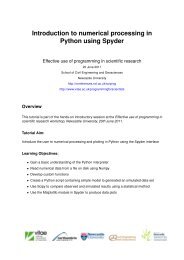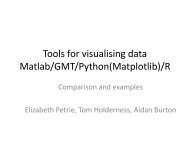Aboriginal placenames in sydney harbour, new south wales
Aboriginal placenames in sydney harbour, new south wales
Aboriginal placenames in sydney harbour, new south wales
You also want an ePaper? Increase the reach of your titles
YUMPU automatically turns print PDFs into web optimized ePapers that Google loves.
ABORIGINAL PLACENAMES IN SYDNEY HARBOUR,<br />
NEW SOUTH WALES, AUSTRALIA – A DUAL NAMING<br />
PROJECT<br />
DR. VAL ATTENBROW<br />
Pr<strong>in</strong>cipal Research Scientist, Anthropology Unit<br />
Australian Museum, Sydney<br />
Australia<br />
vala@austmus.gov.au<br />
Paper Presented at the Forum UNESCO University and Heritage<br />
10th International Sem<strong>in</strong>ar<br />
“Cultural Landscapes <strong>in</strong> the 21st Century”<br />
NewcastleuponTyne, 1116 April 2005<br />
Revised: July 2006<br />
INTRODUCTION<br />
Australia’s <strong>Aborig<strong>in</strong>al</strong> and Torres Strait Islander people have strong connections to the<br />
land and its waterways, and networks of <strong>placenames</strong> were developed to refer to areas<br />
and physical features of the landscape. (Hercus & Simpson, 2002) Placenames form<br />
systems of aidstomemory for identify<strong>in</strong>g places, and are <strong>in</strong>tegral to a group’s<br />
understand<strong>in</strong>g of its history, culture, rights and responsibilities for land. Their formation<br />
varies from region to region, and place to place. For example, <strong>in</strong> some regions<br />
<strong>placenames</strong> are associated with the travels and actions of Ancestral Be<strong>in</strong>gs as they<br />
shaped the land <strong>in</strong>to its present form and they form networks which aid <strong>in</strong> remember<strong>in</strong>g<br />
the location of places as well as the stories associated with the Ancestral Be<strong>in</strong>gs.<br />
(Hercus, 2002; Tamisari, 2002; Wilk<strong>in</strong>s, 2002) However, other <strong>placenames</strong> are<br />
descriptive only and the places stand on their own; some places have more than one<br />
name. In some parts of Australia, such as Central and Western Australia, Arnhem Land<br />
and Cape York, the transmission of knowledge about <strong>placenames</strong> and their<br />
significance to the societies that use them is unbroken from precolonial times to the<br />
present. However, this is not the case for the Sydney region where late 18 th century<br />
British colonisation brought about massive disruption to <strong>Aborig<strong>in</strong>al</strong> societies and the<br />
transmission of traditional knowledge systems.<br />
Around Sydney Harbour (Port Jackson [1] ) and Botany Bay and the <strong>in</strong>terven<strong>in</strong>g coastl<strong>in</strong>e<br />
(an area I refer to as coastal Sydney), over 100 <strong>Aborig<strong>in</strong>al</strong> <strong>placenames</strong> are known,<br />
although the specific locations for all names are not known. (Attenbrow <strong>in</strong> press) Some<br />
names, such as Bondi, Coogee, Parramatta and Woolloomooloo, are still <strong>in</strong> use today.<br />
For many other locations, however, <strong>placenames</strong> given by the British colonists persisted<br />
and their <strong>Aborig<strong>in</strong>al</strong> names have rema<strong>in</strong>ed known to only a few local residents,<br />
historians, l<strong>in</strong>guists and other researchers. However, <strong>in</strong> 2005, under the current NSW<br />
Geographical Names Board Dual Nam<strong>in</strong>g Policy, <strong>Aborig<strong>in</strong>al</strong> <strong>placenames</strong> were re<br />
<strong>in</strong>troduced to Sydney Harbour as dual names to twenty locations which, s<strong>in</strong>ce<br />
colonisation, have been known by only an <strong>in</strong>troduced British name. (Geographical<br />
Names Board of NSW 2004; NSW Government Gazette No. 3, 7 January 2005, pp.<br />
40–41; W<strong>in</strong>dsor <strong>in</strong> press)<br />
As part of my research <strong>in</strong>to the <strong>Aborig<strong>in</strong>al</strong> occupation of the Sydney region, I compiled<br />
a database of <strong>Aborig<strong>in</strong>al</strong> names for places <strong>in</strong> and around Port Jackson and Botany Bay<br />
1
and along the <strong>in</strong>terven<strong>in</strong>g coastl<strong>in</strong>e. (Attenbrow, 2002, Table 2.1) These <strong>Aborig<strong>in</strong>al</strong><br />
<strong>placenames</strong> were orig<strong>in</strong>ally reported by a number of people over a period of 123 years<br />
– from 1788 to 1911. Because of this long history and the contexts of record<strong>in</strong>g, some<br />
issues were encountered when compil<strong>in</strong>g the database. Mak<strong>in</strong>g certa<strong>in</strong>, for example,<br />
that the names had an <strong>Aborig<strong>in</strong>al</strong> orig<strong>in</strong> (which <strong>in</strong>volved identify<strong>in</strong>g when and by whom<br />
they were first reported); that there was a clear association between a placename and<br />
a specific location; and how the names should be written. The database I compiled was<br />
used as a basis by the NSW Geographical Names Board (GNB) to select Sydney<br />
Harbour locations to which dual names could be assigned. The issues that I<br />
encountered <strong>in</strong> compil<strong>in</strong>g my database were also matters that required address<strong>in</strong>g if<br />
dual nam<strong>in</strong>g proposals were to comply with the set of criteria set down by the GNB.<br />
The <strong>placenames</strong> that were <strong>in</strong>cluded <strong>in</strong> the Sydney Harbour Dual Nam<strong>in</strong>g Project are<br />
listed <strong>in</strong> Table 1 and shown on Figure 1. Before discuss<strong>in</strong>g these issues and describ<strong>in</strong>g<br />
the Geographical Names Board’s dual nam<strong>in</strong>g process for Sydney Harbour, a brief<br />
outl<strong>in</strong>e of the historical context <strong>in</strong> which the names were recorded is provided.<br />
A BRIEF HISTORICAL BACKGROUND<br />
In January 1788 the British First Fleet landed on Australia’s <strong>south</strong>eastern coast.<br />
Capta<strong>in</strong> Arthur Phillip was to establish a penal colony, and on board the 11 ships were<br />
over 1000 people – mar<strong>in</strong>es, officers and other officials, as well as convicts. (Phillip,<br />
1790[1892], p. 298]) The first settlement was established <strong>in</strong> Port Jackson, <strong>in</strong> a small<br />
bay the British called Sydney Cove. The <strong>in</strong>itial reactions of the local <strong>Aborig<strong>in</strong>al</strong> people<br />
to the British colonists were mixed – sometimes openly hostile, shout<strong>in</strong>g and angrily<br />
gesticulat<strong>in</strong>g. At other times they were curiously friendly and showed the colonists to<br />
freshwater as they explored the <strong>harbour</strong> and the adjacent country. (Bradley, 1786–<br />
92[1969], p. 59; Tench, 1789, pp. 53–54[1979, p. 35]) At first the local <strong>in</strong>habitants [2]<br />
wandered <strong>in</strong> and looked around the colonists’ settlement <strong>in</strong> Sydney Cove but then they<br />
almost totally avoided the area.<br />
Phillip, as Governor of the colony, had hoped that the local <strong>in</strong>habitants would freely visit<br />
the colonists’ settlement, or that a family would reside with them so they could learn the<br />
local language, enter <strong>in</strong>to a dialogue and learn more about their way of life. However,<br />
the situation, <strong>in</strong> which mean<strong>in</strong>gful dialogue was absent, cont<strong>in</strong>ued for almost two years.<br />
(Phillip, 1790[1892, p. 308]; Tench, 1789, p. 136[1979, p. 73]) As a last resort, a young<br />
man called Arabanoo was captured <strong>in</strong> December 1788 and brought to live <strong>in</strong> Sydney<br />
town. However, Arabanoo died <strong>in</strong> April 1789 dur<strong>in</strong>g an epidemic thought to be<br />
smallpox. (Phillip, 1790[1892, p. 308]) Dur<strong>in</strong>g the epidemic, a young boy and girl,<br />
Nanbaree and Booroong, were brought <strong>in</strong>to the town. (Coll<strong>in</strong>s, 1798[1975, p. 112];<br />
White, 1790[1962, p. 19]) Both survived the disease and stayed <strong>in</strong> the settlement for<br />
some time where they acted as <strong>in</strong>formants and communicators between the British and<br />
the local <strong>in</strong>habitants. The epidemic, however, had a disastrous impact on the local<br />
population – <strong>in</strong> just over a year, well over half the orig<strong>in</strong>al <strong>in</strong>habitants of coastal Sydney<br />
died. (Phillip, 1790[1892, p. 308])<br />
In November 1789, Phillip captured another two men Colbee and Bennelong (Phillip,<br />
1790[1892, p. 300]), though both escaped shortly afterwards. Despite these and<br />
subsequent events, a strong and last<strong>in</strong>g association developed between both men and<br />
Governor Phillip and his officers. The subsequent series of events, dur<strong>in</strong>g which Phillip<br />
was speared <strong>in</strong> September 1790, was the major turn<strong>in</strong>g po<strong>in</strong>t <strong>in</strong> relationships between<br />
the colonists and the local <strong>in</strong>habitants, and marked the end of the local <strong>in</strong>habitants’<br />
<strong>in</strong>dependence and selfreliance. (Hunter, 1793[1968], pp. 204–205)<br />
In the early 1790s, the colony began to expand rapidly – demographically and<br />
geographically. The occupied lands no longer provided a viable subsistence base for<br />
the surviv<strong>in</strong>g <strong>Aborig<strong>in</strong>al</strong> population who could no longer cont<strong>in</strong>ue a traditional way of<br />
2
life. As a result of be<strong>in</strong>g dispossessed from their lands, many people left coastal<br />
Sydney. By 1800, few of the orig<strong>in</strong>al <strong>in</strong>habitants of Sydney Harbour lived around its<br />
shores. However, as relatively peaceful relations came to exist between the colonists<br />
and those who rema<strong>in</strong>ed, <strong>Aborig<strong>in</strong>al</strong> people from neighbour<strong>in</strong>g regions came to live <strong>in</strong><br />
Sydney town and its associated settlements. These <strong>in</strong>cluded a man called Bungaree<br />
and his family who came from the northern shore of Broken Bay, some 35 km to the<br />
north of Port Jackson. The people who now camped together came from much wider<br />
and/or different geographic areas than <strong>in</strong> precolonial times and group composition<br />
(i.e., <strong>in</strong> terms of the clans and/or language groups that people came from) was quite<br />
different. Camps existed <strong>in</strong> many different places <strong>in</strong> the Sydney region until the early<br />
1900s – <strong>in</strong>clud<strong>in</strong>g the foreshores of Sydney Harbour, Botany Bay and the <strong>in</strong>terven<strong>in</strong>g<br />
coastl<strong>in</strong>e.<br />
ORIGINS, ASSOCIATIONS AND SPELLING – PROBLEMS AND UNCERTAINTIES<br />
Several issues arose when I was compil<strong>in</strong>g <strong>in</strong>formation on Sydney <strong>placenames</strong>: (a)<br />
was there a clear association between an <strong>Aborig<strong>in</strong>al</strong> placename and a specific locality?<br />
(b) why are there variations <strong>in</strong> the way some <strong>placenames</strong> were written by different<br />
authors? and (c) what was the orig<strong>in</strong>al source of each placename? These questions<br />
arose for a variety of reasons, and <strong>in</strong> some cases are unlikely to be answered. Issues<br />
pert<strong>in</strong>ent to the dual nam<strong>in</strong>g of Sydney Harbour <strong>placenames</strong> are discussed briefly<br />
below.<br />
Association between name and place<br />
For most <strong>placenames</strong>, an association between the <strong>Aborig<strong>in</strong>al</strong> name and a location<br />
known today by a British placename is unambiguous <strong>in</strong> the way they were listed <strong>in</strong> the<br />
source documents. For some there is a level of uncerta<strong>in</strong>ty, and for other <strong>placenames</strong><br />
an association to a specific location could not be determ<strong>in</strong>ed and was unresolved.<br />
These uncerta<strong>in</strong>ties usually occur because of lack of relevant locational details, illegible<br />
handwrit<strong>in</strong>g, conflict<strong>in</strong>g <strong>in</strong>formation <strong>in</strong> some sources, and possible errors <strong>in</strong> later<br />
records. Only a few <strong>placenames</strong> were marked on maps when orig<strong>in</strong>ally reported. An<br />
example of a list of <strong>Aborig<strong>in</strong>al</strong> <strong>placenames</strong> from Vocabulary…, ca17901792 can be<br />
seen <strong>in</strong> Figure 2. It <strong>in</strong>cludes <strong>Aborig<strong>in</strong>al</strong> <strong>placenames</strong> with clear associations to known<br />
locations with British names (e.g., Botany Bay – Kamay), as well as names for which<br />
the location has not been identified (e.g., a little sandy bay – Weeaggywallar).<br />
Variations <strong>in</strong> spell<strong>in</strong>g<br />
Variations occur <strong>in</strong> the way many of the <strong>placenames</strong> were spelt throughout the 123<br />
years. Late 18 th century variations probably occurred because of the First Fleet officers’<br />
lack of understand<strong>in</strong>g of the sound system of this then unknown <strong>Aborig<strong>in</strong>al</strong> language –<br />
all were hear<strong>in</strong>g it for the first time and most had no l<strong>in</strong>guistic tra<strong>in</strong><strong>in</strong>g. Only William<br />
Dawes (1790–91) provides an orthography which <strong>in</strong>dicates he had some level of<br />
tra<strong>in</strong><strong>in</strong>g. N<strong>in</strong>eteenth and twentieth century authors also often give different spell<strong>in</strong>gs to<br />
the earlier writers, but give no reasons for do<strong>in</strong>g so. Alternative spell<strong>in</strong>gs may be<br />
different <strong>in</strong>terpretations or misread<strong>in</strong>gs by either authors or publishers of orig<strong>in</strong>al hand<br />
writ<strong>in</strong>g, typographical errors, or attempts to use a standard orthography. Incorrect<br />
recollections may account for some variations, especially where <strong>placenames</strong> are<br />
reported <strong>in</strong> late 19 th – early 20 th century rem<strong>in</strong>iscences.<br />
THE SOURCES<br />
<strong>Aborig<strong>in</strong>al</strong> <strong>placenames</strong> <strong>in</strong> and around Sydney Harbour were first recorded by First Fleet<br />
officers <strong>in</strong> 1788 – the first year of British colonisation – with many other <strong>placenames</strong><br />
reported over the next 123 years. Documents that first report an <strong>Aborig<strong>in</strong>al</strong> placename<br />
can be grouped <strong>in</strong>to four ma<strong>in</strong> periods: 1788–1800 [60 names], 1801–1825 [12<br />
names], 1828–1836 [29 names], 1873–1899 [15 names], with only one unreported<br />
placename documented <strong>in</strong> 1860 and another <strong>in</strong> 1911, and they are discussed under<br />
3
these time periods below. At the same time, it should be noted that the date of the first<br />
identified written record of a placename is unlikely to be the time when the placename<br />
first came <strong>in</strong>to use.<br />
No author states clearly the name/s of their <strong>in</strong>formant/s for the <strong>placenames</strong> they report.<br />
By the early 1800s, many people camp<strong>in</strong>g around Sydney Harbour were from other<br />
areas, e.g., Bungaree who was from the northern side of Broken Bay and who <strong>in</strong>itially<br />
came to Port Jackson <strong>in</strong> 1799 when he sailed around Australia with Matthew Fl<strong>in</strong>ders,<br />
and much later (1815) was encouraged to settle with his family on Georges Head<br />
(Attenbrow 2002, p. 107; Smith, 1992). Whether <strong>placenames</strong> recorded after 1800 were<br />
names used prior to British colonisation, or names <strong>in</strong>troduced by people from<br />
neighbour<strong>in</strong>g regions is not stated anywhere but is a possibility. These people from<br />
neighbour<strong>in</strong>g regions may have learnt and used orig<strong>in</strong>al <strong>placenames</strong> from surviv<strong>in</strong>g<br />
members of the Sydney clans, but they may also have given locations <strong>new</strong><br />
<strong>placenames</strong>.<br />
1788–1800: Placenames for over half the locations (60) were recorded by First Fleet<br />
officers between 1788 and 1800. Most are <strong>in</strong> two manuscripts written by Second<br />
Lieutenant William Dawes (1790, 1790–91), which conta<strong>in</strong> relatively extensive<br />
vocabularies and grammar of the language spoken <strong>in</strong> the Sydney region, and a third<br />
document (Vocabulary…, ca 1790–92) attributed to Governor Arthur Phillip, Capta<strong>in</strong><br />
David Coll<strong>in</strong>s and Capta<strong>in</strong> John Hunter. (Troy, 1994, pp. 14–15) Reports, letters and<br />
publications of this period also conta<strong>in</strong> <strong>Aborig<strong>in</strong>al</strong> <strong>placenames</strong>, and a few maps, e.g.,<br />
Grimes 1796 “Plan of the Settlements <strong>in</strong> New South Wales”, show <strong>Aborig<strong>in</strong>al</strong><br />
<strong>placenames</strong> that were adopted for the British settlements (Parramatta, Toongabbe,<br />
Wooloo Mooloo).<br />
For this early period, several listed names cannot be associated with specific places as<br />
locational details are absent or unclear (Fig 2). In addition, where a name has been<br />
recorded by more than one author, spell<strong>in</strong>gs may vary from author to author. (Table 1)<br />
No author states their source/s for the <strong>placenames</strong> though it is clear <strong>in</strong> Dawes’<br />
manuscripts that he obta<strong>in</strong>ed <strong>in</strong>formation about the language and <strong>placenames</strong> from<br />
conversations with local people who were frequent visitors to the settlement; people<br />
such as Bennelong and his wife Barangaroo, and a young woman called Patyegarang<br />
who was Dawes’ ma<strong>in</strong> teacher. (Troy 1992) Bennelong may also have been the source<br />
for <strong>placenames</strong> between Parramatta and Prospect. (Flynn, 1997, pp. 28–29) A<br />
passage by Tench (1793, p. 13[1979, p. 142]) suggests some <strong>placenames</strong> <strong>in</strong><br />
Vocabulary…, (ca 1790–92) came from Arabanoo:<br />
1 st January 1789…the governor took him [Arabanoo] <strong>in</strong> a boat …; <strong>in</strong> go<strong>in</strong>g down<br />
the <strong>harbour</strong> he had described the names by which they dist<strong>in</strong>guish its numerous<br />
creeks and headlands: he was now often heard to repeat that of Weèrong<br />
(Sydney), which was doubtless to <strong>in</strong>form his countrymen of the place of his<br />
captivity; and perhaps <strong>in</strong>vite them to rescue him.<br />
Certa<strong>in</strong>ly, most <strong>placenames</strong> listed <strong>in</strong> Vocabulary…, are for bays and headlands around<br />
the <strong>harbour</strong>.<br />
1801–1825: Twelve additional names are <strong>in</strong> an undated document amongst D’Arcy<br />
Wentworth’s papers which date to the period 1801–1825. The list has six previously<br />
recorded names, though the spell<strong>in</strong>g and location of some names vary from earlier<br />
reports. There is no <strong>in</strong>formation about Wentworth’s sources, though many <strong>Aborig<strong>in</strong>al</strong><br />
people lived <strong>in</strong> and near his property on South Head.<br />
1828–1836: The ma<strong>in</strong> source of <strong>Aborig<strong>in</strong>al</strong> <strong>placenames</strong> for this period is James<br />
Larmer, a surveyor <strong>in</strong> the NSW Surveyor General’s Department from 1829 to 1853. His<br />
1832 lists conta<strong>in</strong> 34 <strong>placenames</strong> <strong>in</strong>clud<strong>in</strong>g 24 that were not <strong>in</strong> earlier documents.<br />
4
Possibly the earliest references to Coogee and Bondi are <strong>in</strong> Larmer’s fieldbooks, and<br />
these names appear on maps of the Town of Sydney of this period, but they are not<br />
identified as <strong>Aborig<strong>in</strong>al</strong> names <strong>in</strong> any of these documents. An undated list by Major<br />
Thomas Mitchell, SurveyorGeneral, which appears to be a copy of Larmer’s 1832 list<br />
(NSW State Records Catalogue Location SZ1002), lists only 32 of the 34 names and<br />
has some variations <strong>in</strong> spell<strong>in</strong>g [3] . The <strong>Aborig<strong>in</strong>al</strong>ity of names <strong>in</strong> Larmer’s (1832[1898])<br />
lists is acknowledged, but not their source. He no doubt saw some names <strong>in</strong> First Fleet<br />
publications and earlier maps, and may have learnt previously unreported names from<br />
<strong>Aborig<strong>in</strong>al</strong> people he met while survey<strong>in</strong>g, as he “had a wide knowledge of the<br />
Aborig<strong>in</strong>es <strong>in</strong> the Coastal districts <strong>in</strong> the neighbourhood adjacent to Sydney” (Stack,<br />
1906, p. 46), perhaps <strong>in</strong>clud<strong>in</strong>g people such as Bungaree, who died <strong>in</strong> 1830.<br />
18541860: Only one previously unrecorded name was documented <strong>in</strong> this period, and<br />
another name (Coogee) which was used <strong>in</strong> Larmer’s documents (e.g. 1832–33 <strong>in</strong><br />
Stack, 1906, p. 52) some 20 years earlier only now appears to be acknowledged as an<br />
<strong>Aborig<strong>in</strong>al</strong> placename (Miles, 1854, p. 41).<br />
1873–1899, 1911: The late 19 th century lists have 15 additional <strong>placenames</strong>, many of<br />
them along the ocean coastl<strong>in</strong>e between Sydney Harbour and Botany Bay. Aga<strong>in</strong> there<br />
are variations <strong>in</strong> spell<strong>in</strong>g and some uncerta<strong>in</strong> provenances. In contrast to earlier<br />
documents, which were mostly handwritten, placename lists were published <strong>in</strong><br />
journals such as the Town and Country Journal and the Science of Man (as well as local<br />
<strong>new</strong>spapers, e.g., the Sydney Morn<strong>in</strong>g Herald.<br />
Aga<strong>in</strong>, late 19 th and early 20 th century authors would have known <strong>placenames</strong> <strong>in</strong> First<br />
Fleet publications and early maps, but they may not have been aware of Dawes’<br />
manuscripts (1790, 1790–91) or Vocabulary…, (ca 1790–92) which had been taken<br />
back to England. Two of the ma<strong>in</strong> authors of this period, George Thornton and Obed<br />
West, lived <strong>in</strong> Sydney from the early part of the century and had contacts with many<br />
<strong>Aborig<strong>in</strong>al</strong> people (Thornton, 1892[1893], pp. 2, 5; West, n.d.[ca 1882], p. 29). Thornton<br />
was a member of the NSW Aborig<strong>in</strong>es Protection Association and the NSW Aborig<strong>in</strong>es<br />
Protection Board. An <strong>Aborig<strong>in</strong>al</strong> man known as “Ricketty Dick”, who died <strong>in</strong> 1863, may<br />
have been one of their <strong>in</strong>formants (Hunt<strong>in</strong>gdon, 1911, p. 167). “Ricketty Dick” camped<br />
with a community that <strong>in</strong>cluded Bungaree’s wife, Queen Gooseberry, and that<br />
frequented Sydney Town, Rose Bay and the bays between South Head and Botany<br />
Bay.<br />
THE NSW GEOGRAPHICAL NAMES BOARD DUAL NAMING POLICY AND<br />
SYDNEY HARBOUR PROPOSAL<br />
In 1992 the Committee for Geographical Names <strong>in</strong> Australasia recommended that “A<br />
dual nam<strong>in</strong>g system or use of alternative names, may be used as a management and<br />
educative tool for the nam<strong>in</strong>g of physical and environmental features of significance to<br />
the local <strong>Aborig<strong>in</strong>al</strong> and Torres Strait Islander Community when an official name<br />
already exists and when a name change is not possible or acceptable.” (Geographical<br />
Names Board of NSW, 2001, p. 7) A dual nam<strong>in</strong>g policy was approved for New South<br />
Wales by the M<strong>in</strong>ister of Lands <strong>in</strong> June 2001.<br />
The NSW dual nam<strong>in</strong>g policy aims to ensure that <strong>Aborig<strong>in</strong>al</strong> <strong>placenames</strong> are<br />
recognised by all Australians as an <strong>in</strong>tegral part of Australia’s heritage that needs to be<br />
preserved; and, to encourage greater recognition of <strong>Aborig<strong>in</strong>al</strong> heritage and<br />
custodianship of geographical names. It recognises that both European and Indigenous<br />
names reflect the history, culture and identity of New South Wales, and acknowledges<br />
the historical and cont<strong>in</strong>u<strong>in</strong>g l<strong>in</strong>k between <strong>Aborig<strong>in</strong>al</strong> people, the land and sea.<br />
Shortly after approval of the policy, the GNB assigned dual names to two places <strong>in</strong> the<br />
Sydney region: Dawes Po<strong>in</strong>t / Tara on Sydney Harbour (October 2002) and South<br />
5
Creek / Wianamatta <strong>in</strong> western Sydney (March 2003). Then, <strong>in</strong> April 2003 the GNB<br />
appo<strong>in</strong>ted a Technical and Scientific Subcommittee to <strong>in</strong>vestigate and make<br />
recommendations on other possible dual names with<strong>in</strong> NSW. The subcommittee,<br />
work<strong>in</strong>g with the Australian National Placenames Survey, decided to pursue dual<br />
nam<strong>in</strong>g of a series of places <strong>in</strong> and around Sydney Harbour, us<strong>in</strong>g placename lists that<br />
I had compiled. This process culm<strong>in</strong>ated at the end of 2004, when the Board assigned<br />
dual names to 20 places <strong>in</strong> and around Sydney Harbour.<br />
For the dual names to be assigned, the proposal had to comply with a set of criteria set<br />
down by the GNB: there must be historical evidence <strong>in</strong> the form of written or oral<br />
tradition, that the feature has two exist<strong>in</strong>g names – an <strong>Aborig<strong>in</strong>al</strong> name and a British<br />
name (i.e., the name cannot be <strong>new</strong>); the <strong>Aborig<strong>in</strong>al</strong> name shall be <strong>in</strong>digenous to the<br />
local area <strong>in</strong> New South Wales; the dual nam<strong>in</strong>g system will apply only to already<br />
named geographic features such as rivers, creeks, waterfalls, beaches, <strong>harbour</strong>s,<br />
islands, and not to “address features” such as the names of suburbs or streets; the<br />
dual nam<strong>in</strong>g system is to be communitydriven and the GNB will receive and consider<br />
applications put forward by local <strong>Aborig<strong>in</strong>al</strong> communities; and, only nom<strong>in</strong>ations with an<br />
agreed s<strong>in</strong>gle spell<strong>in</strong>g for the dual name will be supported. (Geographical Names<br />
Board of NSW, 2004; W<strong>in</strong>dsor <strong>in</strong> press)<br />
The Subcommittee therefore selected <strong>placenames</strong> that were not only historically<br />
documented but also had a clear association between the name and the location. The<br />
possibility that some <strong>placenames</strong> first recorded <strong>in</strong> the 1830s had been given by<br />
<strong>Aborig<strong>in</strong>al</strong> people from outside coastal Sydney was considered not to negate their<br />
<strong>in</strong>clusion as, even if proven, they were still <strong>Aborig<strong>in</strong>al</strong> names and were part of the<br />
history of this area. Decid<strong>in</strong>g on a “s<strong>in</strong>gle spell<strong>in</strong>g” was more difficult. Several places<br />
had multiple spell<strong>in</strong>gs recorded and it seemed that the orthographies used by different<br />
people at different times also varied, so there was no consistency between the<br />
spell<strong>in</strong>gs and the way they may have been voiced. L<strong>in</strong>guists Dr Michael Walsh and<br />
Jakel<strong>in</strong> Troy, who were members of the Subcommittee, studied each of the names,<br />
assessed how they considered they would have orig<strong>in</strong>ally been voiced by <strong>Aborig<strong>in</strong>al</strong><br />
people from this part of the cont<strong>in</strong>ent, and rewrote the names accord<strong>in</strong>g to a s<strong>in</strong>gle<br />
orthography.<br />
The selected <strong>placenames</strong> and suggested spell<strong>in</strong>gs were presented to a workshop of<br />
local <strong>Aborig<strong>in</strong>al</strong> community representatives and <strong>in</strong>dividuals from across the Sydney<br />
region <strong>in</strong> October 2003 (Patterson, 2003). The workshop approved the selected names<br />
with some ref<strong>in</strong>ements to the way names were to be written (Table 1). The Committee<br />
submitted these 20 dual names to the GNB. In 2004, affected government departments<br />
and local councils were consulted and the proposed 20 dual names were advertised <strong>in</strong><br />
the local Sydney press, the Koori Mail, and NSW Government Gazette (Skelsey, 2004).<br />
After this process, the GNB recommended to the M<strong>in</strong>ister of Lands that the 20 dual<br />
names <strong>in</strong> Sydney Harbour be assigned. The names were formally gazetted 7 January<br />
2005. (NSW Government Gazette No. 3, 7 January 2005, pp. 40–41).<br />
The Sydney Harbour proposal was just the beg<strong>in</strong>n<strong>in</strong>g of the process to assign dual<br />
names to other places <strong>in</strong> New South Wales. Dual nam<strong>in</strong>g proposals for two further<br />
locations <strong>in</strong> Sydney Harbour (North Head and South Head) and other regions <strong>in</strong> New<br />
South Wales are currently be<strong>in</strong>g <strong>in</strong>vestigated.<br />
ACKNOWLEDGEMENTS<br />
Many thanks to Flavia Hodges of the Australian National Placenames Survey and Greg<br />
W<strong>in</strong>dsor of the Geographical Names Board of NSW for <strong>in</strong>vit<strong>in</strong>g me to participate <strong>in</strong> the<br />
process towards dual nam<strong>in</strong>g these geographical features around Sydney Harbour.<br />
Thanks also to Susannah Rayner, Head of Archives and Special Collections at the<br />
6
School of Oriental and African Studies <strong>in</strong> London, and photographer Glenn Ratcliffe for<br />
facilitat<strong>in</strong>g a speedy delivery of the images of pages from the Dawes manuscript.<br />
NOTES<br />
[1] Port Jackson is generally known as Sydney Harbour, but Sydney Harbour is only<br />
one of three <strong>harbour</strong>s <strong>in</strong> Port Jackson, the others be<strong>in</strong>g Middle Harbour and North<br />
Harbour.<br />
[2] I use the term “the local <strong>in</strong>habitants” as the Sydney region was <strong>in</strong>habited by<br />
numerous clans, each affiliated with a specific area of land, and I am talk<strong>in</strong>g<br />
generally about more than one clan. There is also much debate about the number of<br />
language groups and/or dialects <strong>in</strong> the region and the names by which they should<br />
be referred. (Attenbrow, 2002, pp. 22–35)<br />
[3] T.L. Mitchell’s document consists of two undated pages filed <strong>in</strong> papers dat<strong>in</strong>g from<br />
1801 to 1849. If they are copies of Larmer’s list of <strong>placenames</strong>, then they probably<br />
date to sometime after 1830 and before 1849.<br />
7
REFERENCES<br />
Attenbrow, V.J. (2002) Sydney’s <strong>Aborig<strong>in</strong>al</strong> Past. (Sydney, UNSW Press).<br />
Attenbrow, V.J. (<strong>in</strong> press) <strong>Aborig<strong>in</strong>al</strong> <strong>placenames</strong> around Port Jackson and Botany<br />
Bay, NSW, Australia – sources and uncerta<strong>in</strong>ties, <strong>in</strong>: Hercus, L. & H. Koch (Eds)<br />
<strong>Aborig<strong>in</strong>al</strong> Placenames Old and New.<br />
Bradley, W. (1786–92[1969]) A Voyage to New South Wales. The Journal of<br />
Lieutenant William Bradley RN of HMS Sirius 1786–1792. (Facsimile. Sydney,<br />
The Trustees of the Public Library of NSW <strong>in</strong> association with Ure Smith).<br />
Coll<strong>in</strong>s, D. (1798[1975]) An Account of the English Colony <strong>in</strong> New South Wales. Vol.<br />
1. T. Cadell Jun. & W. Davies, (London, The Strand [Sydney, A.H. & A.W. Reed <strong>in</strong><br />
association with Royal Australian Historical Society]).<br />
Dawes, W. (1790) Grammatical forms of the language of N.S. Wales, <strong>in</strong> the<br />
neighbourhood of Sydney, by –– Dawes, <strong>in</strong> the year 1790. Manuscript <strong>in</strong> Library of<br />
School of Oriental & African Studies, London. Marsden Collection Ms 41645(a).<br />
Microfilm <strong>in</strong> Mitchell Library of State Library of NSW, Ref. FM4/3431, Reel 5,<br />
frames 771–794.<br />
Dawes, W. (1790–1791) Vocabulary of the language of N.S. Wales, <strong>in</strong> the<br />
neighbourhood of Sydney (Native and English) by –– Dawes. Manuscript <strong>in</strong> Library<br />
of School of Oriental and African Studies, London. Marsden Collection, Ms<br />
41645(b). Microfilm <strong>in</strong> Mitchell Library of State Library of NSW, Ref. FM4/3431,<br />
Reel 5, frames 795–817.<br />
Flynn, M. (1997) Holroyd History and the Silent Boundary Project. Unpublished report<br />
for Holroyd City Council<br />
Geographical Names Board of NSW (2001) Dual Nam<strong>in</strong>g – Policy and Guidel<strong>in</strong>es.<br />
NSW Department of Information, Technology and Management, Sydney.<br />
Geographical Names Board of NSW (2004) Dual Nam<strong>in</strong>g – Support<strong>in</strong>g cultural<br />
recognition. Information Kit 1 May 2004.<br />
http://www.gnb.nsw.gov.au/<strong>in</strong>fo/dual_nam<strong>in</strong>g.pdf<br />
Hercus, L. (2002) Is it really a placename? <strong>in</strong>: Hercus, L., F. Hodges, & J. Simpson<br />
(Eds) The Land is A Map, pp. 1–23. (Canberra, Pandanus Press).<br />
Hercus, L. & J. Simpson (2002) Indigenous <strong>placenames</strong>: an <strong>in</strong>troduction, <strong>in</strong>: Hercus, L.,<br />
F. Hodges & J. Simpson (Eds) The Land is A Map, pp. 1–23. (Canberra,<br />
Pandanus Press).<br />
Hunter, J. (1793[1968]) An Historical Journal of the Transactions at Port Jackson<br />
and Norfolk Island, ... <strong>in</strong>clud<strong>in</strong>g the journals of Governors Phillip and K<strong>in</strong>g,<br />
and of Lieut. Ball; … (London, John Stockdale [Facsimile. Adelaide, Libraries<br />
Board of South Australia]).<br />
Hunt<strong>in</strong>gdon, W.H. (1911) The Mean<strong>in</strong>g of the Word “Woolloomooloo”, August 16 th ,<br />
1902, Science of Man,14(8), pp.166–169.<br />
Larmer, J. (1832[1898]) Native names of po<strong>in</strong>ts of land <strong>in</strong> Port Jackson (<strong>south</strong> shore) and<br />
native names of po<strong>in</strong>ts of land, north shore of Port Jackson, reproduced <strong>in</strong> Native<br />
vocabulary of miscellaneous New South Wales objects, Journal of the Royal<br />
Society of New South Wales, 32, pp. 223–229.<br />
Miles, W.A. (1854) How did the natives of Australia become acqua<strong>in</strong>ted with the<br />
demigods and daemonia, and with the superstitions of the ancient races? and how<br />
have many oriental words been <strong>in</strong>corporated <strong>in</strong> their dialects and languages?<br />
Journal of the Ethnological Society of London 3, pp. 4–50.<br />
Mitchell, T.L. (n.d.) Native names of po<strong>in</strong>ts and islands <strong>in</strong> Port Jackson. In Sir Thomas<br />
Liv<strong>in</strong>gstone Mitchell. Papers. Vol. 8 Miscellaneous ca 1801–1849, pp. 419–420.<br />
Manuscript. Mitchell Library of State Library of NSW. Reference A.295/3, CY Reel<br />
248, frames 328–329.<br />
NSW Government Gazette No. 3, 7 January 2005.<br />
Patterson, J. (2003) Will Potts Po<strong>in</strong>t be Derrawunn? The Koori Mail, Wednesday 17<br />
December 2003, p. 24.<br />
8
Phillip, A. (1790[1892]) Letters from Governor Phillip to Lord Sydney, Government<br />
House, Sydney Cove, 12 th and 13 th February 1790, Historical Records of New<br />
South Wales 1(2), pp. 293–210. (Sydney, Government Pr<strong>in</strong>ter).<br />
Skelsey, M. (2004) Sydney to <strong>harbour</strong> a double identity. Daily Telegraph, Tuesday 29<br />
June 2004, p. 11.<br />
Stack, E. (1906) Native names and mean<strong>in</strong>gs, 1906. Extracted from notes by J. Larmer<br />
1832–1833. Typescript. Mitchell Library of State Library of NSW, Ref. DL MS.23;<br />
Microfilm CY Reel 4355, frames 43–57.<br />
Smith, K. (1992) K<strong>in</strong>g Bungaree. (Sydney, Kangaroo Press).<br />
Tamisari, F. (2002) Names and nam<strong>in</strong>g: speak<strong>in</strong>g forms <strong>in</strong>to place, <strong>in</strong>: Hercus, L., F.<br />
Hodges & J. Simpson (Eds) The Land is A Map, pp. 87–102. (Canberra,<br />
Pandanus Press).<br />
Tench, W. (1789,1793[1979]) Sydney's First Four Years. (Sydney, Library of Australian<br />
History <strong>in</strong> association with Royal Australian Historical Society).<br />
Thornton, G. (1892[1893]) Notes on the Aborig<strong>in</strong>es of New South Wales. Appendix, <strong>in</strong>:<br />
J. Fraser (Ed.) The Aborig<strong>in</strong>es of New South Wales, pp. 2–8. (Sydney, New<br />
South Wales Commissioners for the World's Columbian Exposition, Chicago,<br />
1893).<br />
Troy, J. (1992) The Sydney language notebooks and responses to language contact <strong>in</strong><br />
colonial NSW, Australian Journal of L<strong>in</strong>guistics, 12, pp. 145–170.<br />
Troy, J. (1994) The Sydney Language. (Canberra, Jakel<strong>in</strong> Troy).<br />
Vocabulary of the language of N.S. Wales <strong>in</strong> the neighbourhood of Sydney. (Native and<br />
English but not alphabetical). (ca 1790–92) Manuscript <strong>in</strong> Library of School of<br />
Oriental and African Studies, London. Marsden Collection. Ms 41645 (c). Microfilm<br />
<strong>in</strong> Mitchell Library of State Library of NSW. Ref. FM4/3432, Reel 6, frames 342–66.<br />
Wentworth, D. (1801–1825) Papers of D’Arcy Wentworth from the estate of Miss Dorothy<br />
Wentworth 1801–1825. Manuscript. Mitchell Library of State Library of NSW.<br />
Reference No A4073.<br />
West, O. (n.d.[ca 1882]) XX–Our <strong>harbour</strong> and ocean bays. Old and New Sydney No 6,<br />
pp. 22–32. Repr<strong>in</strong>ted from The Sydney Morn<strong>in</strong>g Herald by permission of the<br />
proprietors. (Sydney, Edward Hordern & Sons).<br />
White, J. (1790[1962]) Journal of a Voyage to New South Wales. (Piccadilly,<br />
London, J. Debrett. [Sydney, Angus & Robertson <strong>in</strong> assoc. Royal Australian<br />
Historical Society].<br />
Wilk<strong>in</strong>s, D.P. (2002) The concept of place among the Arrernte, <strong>in</strong>: Hercus, L., F.<br />
Hodges & J. Simpson (Eds) The Land is A Map, pp. 24–41. (Canberra, Pandanus<br />
Press).<br />
W<strong>in</strong>dsor, G. (<strong>in</strong> press) The Recognition of <strong>Aborig<strong>in</strong>al</strong> Placenames <strong>in</strong> New South Wales<br />
(Australia). Geographical Names Board of N.S.W, <strong>in</strong>: Hercus, L. & H. Koch (Eds)<br />
<strong>Aborig<strong>in</strong>al</strong> Placenames Old and New.<br />
9
Table 1. <strong>Aborig<strong>in</strong>al</strong> <strong>placenames</strong> <strong>in</strong>cluded <strong>in</strong> the Sydney Harbour Dual Nam<strong>in</strong>g Project<br />
– variations <strong>in</strong> orig<strong>in</strong>al spell<strong>in</strong>gs and locations, and spell<strong>in</strong>gs adopted <strong>in</strong> 2005. [words<br />
and letters <strong>in</strong> square brackets are my <strong>in</strong>sertions]<br />
ABORIGINAL<br />
NAME<br />
BRITISH NAME<br />
IN REFERENCE<br />
REFERENCE PRESENT<br />
NAME<br />
DUAL NAME<br />
SPELLING 2005<br />
Kuba Kaba Middle H[ead] Dawes 179091 Middle Head Gubbah Gubbah 1<br />
Cabacaba Middle Do [i.e., Vocabulary… ca<br />
Middle Head] 179092<br />
Caba Caba The middle head Coll<strong>in</strong>s<br />
of Port Jackson 1798[1975]<br />
Koreé Chowder Bay Larmer<br />
1832[1898]<br />
Chowder Bay Gooree 2<br />
Koree Chouder [sic] Mitchell n.d. [ca<br />
183049]<br />
Gurugal West Head Larmer<br />
Chowder Gooragal 3<br />
1832[1898] Head<br />
Gurrugal West Head Mitchell n.d. [ca<br />
183049]<br />
Gurugal Gurugal written Co. of<br />
on map adjacent Cumberland<br />
to Chowder Parish map, n.d.<br />
Head<br />
[prob. 1860s]<br />
Booragy Bradley's Po<strong>in</strong>t Dawes 179091 Bradleys Booraghee 4<br />
Búrroggy Bradley's Head Larmer<br />
1832[1898]<br />
Head<br />
Burròggy, Broggy Bradley's Po<strong>in</strong>t Mitchell n.d. [ca<br />
183049]<br />
Goram bullagong Mossman’s Larmer<br />
Whal<strong>in</strong>g<br />
Establishment /<br />
Sirius Cove<br />
1832[1898]<br />
Gorambùllagong Mossmans<br />
Whal<strong>in</strong>g Est t<br />
Mosman Bay Goram Bullagong 5<br />
Mitchell n.d. [ca<br />
183049]<br />
Wéyé Wéyé Careen<strong>in</strong>g Larmer<br />
Careen<strong>in</strong>g Weeyuh Weeyuh 6<br />
Cove Head 1832[1898] Cove<br />
Weeawya Careen<strong>in</strong>g Mitchell n.d. [ca<br />
Cove<br />
183049]<br />
Quibéreé Hulk Bay Larmer<br />
Lavender Gooweebahree 7<br />
1832[1898] Bay<br />
Quiberee Hulk Bay Mitchell n.d. [ca<br />
183049]<br />
Warung áréá Billy Blues Larmer<br />
Blues Po<strong>in</strong>t Warungareeyuh 8<br />
Po<strong>in</strong>t<br />
1832[1898]<br />
Warrungarea Billy Blues Mitchell n.d. [ca<br />
Po<strong>in</strong>t<br />
183049]<br />
Gomora Long Cove Vocabulary… ca Darl<strong>in</strong>g Tumbalong 9<br />
1790–92 Harbour<br />
Tumbulong Darl<strong>in</strong>g<br />
Larmer<br />
Harbour<br />
1832[1898]<br />
Tumbulong Darl<strong>in</strong>g<br />
Mitchell n.d. [ca<br />
Harbour<br />
183049]<br />
No.<br />
on<br />
MAP<br />
10
MeliaWool A small cove<br />
with<strong>in</strong> [i.e., with<strong>in</strong><br />
Sydney Cove]<br />
Vocabulary… ca<br />
1790–92<br />
Warran Sydney Cove Vocabulary… ca<br />
179092<br />
Warran Sydney Cove Vocabulary … ca<br />
179092<br />
Weérong Sydney Tench<br />
1793:13[1979]<br />
Warrane Sydney Cove K<strong>in</strong>g <strong>in</strong> Hunter<br />
1793[1968]<br />
Warrang Sydney Cove Meehan 1807,<br />
1811 maps<br />
Tubowgule Sydney Cove E Vocabulary… ca<br />
Po<strong>in</strong>t<br />
Tubowgule The eastern po<strong>in</strong>t<br />
of the cove [i.e.,<br />
Sydney Cove]<br />
Toobowguliè The po<strong>in</strong>t (near<br />
179092<br />
Phillip <strong>in</strong> Hunter<br />
1793[1968]<br />
Campbells<br />
Cove<br />
Meeliyahwool 10<br />
Sydney Cove Warrane 11<br />
Bennelong<br />
Po<strong>in</strong>t<br />
Dubbagullee 12<br />
First Govt House)<br />
Coll<strong>in</strong>s<br />
1798[1975]<br />
Tobegully Name placed on Meehan 1807,<br />
map on western<br />
shore of Farm<br />
Cove<br />
1811 maps<br />
Jubughalee Bennelong Larmer<br />
Po<strong>in</strong>t<br />
1832[1898]<br />
Jubùghallee Bennelong Mitchell n.d. [ca<br />
Po<strong>in</strong>t<br />
183049]<br />
Wogganmagule Farm Cove Vocabulary… ca<br />
1790–92<br />
Farm Cove Wahganmuggalee 13<br />
Woccanmagully Name placed on Meehan 1807,<br />
map <strong>in</strong> Farm Cove 1811 maps<br />
Yuron East bank of do Vocabulary… ca Mrs Yurong 14<br />
[Farm Cove] 1790–92 Macquaries<br />
Yurong Name placed on Meehan 1807, Po<strong>in</strong>t<br />
map on pen<strong>in</strong>sula 1811 maps<br />
Urong Lady Macquarie’s Wentworth<br />
chair<br />
1801–25<br />
Yourong Mrs<br />
Larmer<br />
Macquarie’s<br />
Po<strong>in</strong>t<br />
1832[1898]<br />
Yurong Mrs<br />
Mitchell n.d. [ca<br />
Macquaries Pt 183049]<br />
Mattewanye 4th or Rock Vocabulary… ca Fort Denison Muddawahnyuh 15<br />
Island<br />
1790–92 / P<strong>in</strong>chgut Is.<br />
Mattewanye The small island Coll<strong>in</strong>s<br />
which is situated<br />
<strong>in</strong> the middle of<br />
the <strong>harbour</strong><br />
1802[1971]<br />
Mattewai P<strong>in</strong>ch Gut Larmer 1832 <strong>in</strong><br />
Island<br />
Stack 1906<br />
Derawun East po<strong>in</strong>t of do Vocabulary… ca Potts Po<strong>in</strong>t Derrawunn 16<br />
[i.e., cove next<br />
to Farm Cove]<br />
1790–92<br />
11
Carrag<strong>in</strong>n Next cove [cove<br />
next to cove next<br />
to Farm Cove]<br />
Vocabulary… ca<br />
1790–92<br />
Jerrowan Elizabeth Po<strong>in</strong>t Larmer<br />
1832[1898]<br />
Jèrrowan Elizabeth Po<strong>in</strong>t Mitchell n.d. [ca<br />
183049]<br />
Yarrandab… Mr McLeay’s Larmer<br />
[illeg.]<br />
Po<strong>in</strong>t<br />
1832[1898]<br />
Yarrandabby Mr McLeay’s Mitchell n.d. [ca<br />
Po<strong>in</strong>t<br />
183049]<br />
Boamillie 1st island com<strong>in</strong>g Vocabulary… ca<br />
up the <strong>harbour</strong> 179092<br />
Boam bill... [illeg.] Shark Island Larmer<br />
1832[1898]<br />
Boambilly Shark Island Mitchell n.d. [ca<br />
183049]<br />
Elizabeth<br />
Bay<br />
Elizabeth<br />
Po<strong>in</strong>t<br />
Elizabeth<br />
Po<strong>in</strong>t<br />
Macleay<br />
Po<strong>in</strong>t<br />
Gurraj<strong>in</strong> 17<br />
Jerrowan 18<br />
Yurrandubbee 19<br />
Shark Island Boowambillee 20<br />
12


